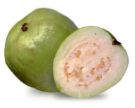
|
GUAVA |

|
-
Basic information
- Where are they grown?
- The place of origin of the guava is uncertain, but it is believed to be an area extending from southern Mexico into or through Central America. It has been spread by man, birds and other animals to all warm areas of tropical America and in the West Indies (since 1526). Like other tender subtropicals, guavas need a frost-free location, but are not too fussy otherwise. They prefer full sun. Guava (from Spanish Guayaba; Goiaba in Portuguese) is a genus of about 100 species of tropical shrubs and small trees in the myrtle family Myrtaceae, native to the Caribbean, Central America and northern South America.
- Where is the guava in season?
- The guava thrives in both humid and dry climates. In India, it flourishes up to an altitude of 3,280 ft (1,000 m); in Jamaica, up to 3,906 ft (1,200 m); in Costa Rica, to 4,590 ft (1,400 m); in Ecuador, to 7,540 ft (2,300 m). It can survive only a few degrees of frost. Young trees have been damaged or killed in cold spells at Allahabad, India, in California and in Florida. Older trees, killed to the ground, have sent up new shoots which fruited 2 years later. The guava requires an annual rainfall between 40 and 80 in (1,000-2,000 mm); is said to bear more heavily in areas with a distinct winter season than in the deep Tropics.
- How do you know the Guava is ripe?
- The fruit matures 90 to 150 days after flowering. Generally, there are 2 crops per year in southern Puerto Rico; the heaviest, with small fruits, in late summer and early fall; another, with larger fruits, in late winter and early spring. In northern India, the main crop ripens in mid-winter and the fruits are of the best quality. A second crop is home in the rainy season but the fruits are less abundant and watery. Growers usually withhold irrigation after December or January or root-prune the trees in order to avoid a second crop. The trees will shed many leaves and any fruits set will drop. An average winter crop in northern India is about 450 fruits per tree. Trees may bear only 100-300 fruits in the rainy season but the price is higher because of relative scarcity despite the lower quality. Of course, yields vary with the cultivar and cultural treatment. Experiments have shown that spraying young guava trees with 25% urea plus a wetting agent will bring them into production early and shorten the harvest period from the usual 15 weeks to 4 weeks.
- Vitamines
- It is rich in vitamins A, B, and C [a guava fruit contains more vitamin C than a typical citrus fruit – the rind contains over five times more vitamin C than an orange]. It also contains high amounts of calcium – which is unusual in a
 |
HEDGE APPLE AUBERGINE KIWI CHERIMOYA JUCK FRUIT GUARANA KUMQUAT MANGO |
|
If you need more information you can go to the web side Frutas and if you have any question o comment Send e-mail